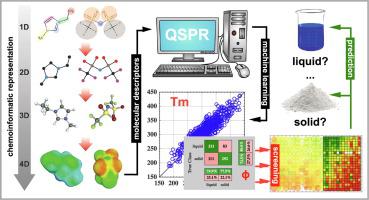Journal of Molecular Liquids ( IF 6 ) Pub Date : 2021-09-25 , DOI: 10.1016/j.molliq.2021.117631 Kamil Paduszyński 1 , Krzysztof Kłębowski 1 , Marta Królikowska 1

|
Quantitative structure–property relationships (QSPRs) for predicting melting point temperature () of ionic liquids (ILs) are reviewed and the new models are proposed by using the experimental data extracted from the literature for 953 salts. The models include both regression of data and classification of the ILs with respect to their state of matter (liquid/solid) at K. A variety of machine learning algorithms is applied, including: partial least squares regression, stepwise multiple linear regression, and a number of common classifiers (k-nearest neighbors, naive Bayes, linear discriminant analysis, support vector machines). An effect of the molecular descriptors set as well as the computational level used for the ions’ geometry optimization is analyzed and followed in the final model selection protocol, which comprises all the standard steps of good practice of QSRP modeling, e.g. cross-validation, external validation, and the applicability domain analysis. Furthermore, as a key novelty, the robustness of the models is checked for different combining rules, defined as the averaging functions for obtaining the descriptors of ILs from those given for individual ions. The finally selected and recommended models are discussed in detail in terms of various statistics, as well as addressed to other methods reported in the literature. An effect of the chemical family of both cation and anion on the modeling performance is highlighted. Additionally, the predictions of both and state of matter of more than virtual cation–anion combinations are given in order to present the range of potential applications of the new methods in computer-aided molecular design of new ILs displaying demanded phase behavior.
中文翻译:

使用 QSPR 方法预测离子液体的熔点:文献综述和新模型
用于预测熔点温度的定量结构-性质关系(QSPR)() 的离子液体 (IL) 进行了审查,并使用从文献中提取的 953 盐的实验数据提出了新模型。这些模型包括两个回归 IL 相对于其物质状态(液体/固体)的数据和分类 K. 应用了多种机器学习算法,包括:偏最小二乘回归、逐步多元线性回归,以及一些常见的分类器(k-最近邻、朴素贝叶斯、线性判别分析、支持向量机)。分析了分子描述符集的影响以及用于离子几何优化的计算水平,并在最终模型选择协议中遵循,该协议包括 QSRP 建模良好实践的所有标准步骤,例如交叉验证、外部验证和适用性域分析。此外,作为一个关键的新颖之处,针对不同的组合规则检查模型的稳健性,定义为从为单个离子给出的那些中获得 IL 描述符的平均函数。最终选择和推荐的模型根据各种统计数据进行了详细讨论,并针对文献中报道的其他方法进行了讨论。突出显示了阳离子和阴离子的化学族对建模性能的影响。此外,双方的预测 和物质状态超过 给出了虚拟阳离子 - 阴离子组合,以展示新方法在计算机辅助分子设计中显示所需相行为的新 IL 的潜在应用范围。



























 京公网安备 11010802027423号
京公网安备 11010802027423号